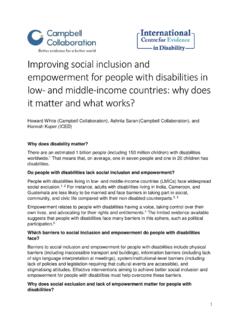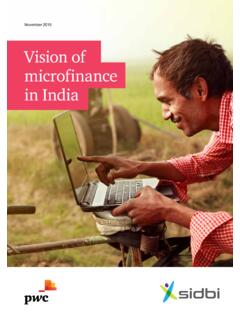Transcription of Gender Transformative Approaches
1 GenderTransformativeApproachesJoint Programme on for Food Security and NutritionFood and Agriculture Organization of the United Nations International Fund for Agricultural Development World Food ProgrammeRome, 2020 Required citation: FAO, IFAD and WFP. 2020. Gender Transformative Approaches for food security, improved nutrition and sustainable agriculture A compendium of fifteen good practices. Rome. designations employed and the presentation of material in this information product do not imply the expression of any opinion whatsoever on the part of the Food and Agriculture Organization of the United Nations (FAO), the International Found for Agricultural Development (IFAD) or the World Food Programme (WFP) concerning the legal or development status of any country, territory, city or area or of its authorities, or concerning the delimitation of its frontiers or boundaries.
2 The mention of specific companies or products of manufacturers, whether or not these have been patented, does not imply that these have been endorsed or recommended by FAO, IFAD or WFP in preference to others of a similar nature that are not views expressed in this information product are those of the author(s) and do not necessarily reflect the views or policies of FAO, IFAD or WFP. ISBN 978-92-5-133397-6 [FAO] FAO, IFAD and WFP, 2020 Some rights reserved. This work is made available under the Creative Commons Attribution-NonCommercial-ShareAlike IGO licence (CC BY-NC-SA IGO; ). Under the terms of this licence, this work may be copied, redistributed and adapted for non-commercial purposes, provided that the work is appropriately cited.
3 In any use of this work, there should be no suggestion that FAO, IFAD and WFP endorse any specific organization, products or services. The use of the FAO, IFAD and WFP logos are not permitted. If the work is adapted, then it must be licensed under the same or equivalent Creative Commons license. If a translation of this work is created, it must include the following disclaimer along with the required citation: This translation was not created by the Food and Agriculture Organization of the United Nations (FAO), the International Fund for Agricultural Development (IFAD) or the World Food Programme (WFP). FAO is not responsible for the content or accuracy of this translation. Disputes arising under the licence that cannot be settled amicably will be resolved by mediation and arbitration as described in Article 8 of the licence except as otherwise provided herein.
4 The applicable mediation rules will be the mediation rules of the World Intellectual Property Organization and any arbitration will be in accordance with the Arbitration Rules of the United Nations Commission on International Trade Law (UNCITRAL).Third-party materials. Users wishing to reuse material from this work that is attributed to a third party, such as tables, figures or images, are responsible for determining whether permission is needed for that reuse and for obtaining permission from the copyright holder. The risk of claims resulting from infringement of any third-party-owned component in the work rests solely with the , rights and licensing. FAO information products are available on the FAO website ( ) and can be purchased through Requests for commercial use should be submitted via: Queries regarding rights and licensing should be submitted to: ivAbbreviations and acronyms vPart 1 Introduction and synthesis of fifteen Gender Transformative approaches1.
5 Introduction 32. Synthesis of fifteen Gender Transformative Approaches 52 1 Core characteristics of the fifteen Gender Transformative Approaches 62 2 Implementation arrangements 62 3 Implementation cycle 102 4 Results of Gender Transformative Approaches 122 5 Key
6 Success factors and challenges 143. Concluding remarks 17 Part 2 Fifteen good practices of Gender Transformative approaches1. Gender Action Learning System 212. Gender Household Approach 313. Gender Model Family 394.
7 Individual Household Mentoring 495. Journeys of Transformation or Engaging Men as Allies in Women s economic empowerment 596. Nurturing Connections 697. Community Conversations 778. Dimitra Clubs 859.
8 Farmers Field and Business Schools 9710. Farmer Field and Life School 10711. Gender Mainstreaming in Member-based Organizations 11512. Social Analysis and Action, Ethiopia 12513. Models to Empower Women in Outgrower Schemes 13314.
9 Joint Programme to Accelerate Progress towards the economic empowerment of Rural Women 14115. GENNOVATE 151 ContentsivAcknowledgementsThis compendium was prepared by Clare Bishop, Independent Gender Consultant. It was technically reviewed by Lo s Archimbaud, Gender Consultant, FAO, under the supervision of Susan K. Kaaria, Senior Gender Officer, FAO and Hajnalka Petrics, Programme Officer ( Gender Equality and Women s empowerment ) and Global Coordinator of the Joint Programme on Gender Transformative Approaches for Food Security, Improved Nutrition and Sustainable Agriculture (JP GTA).
10 The following people have technically reviewed the synthesis chapter of the compendium: Susan K. Kaaria, FAO; Hajnalka Petrics, FAO; Lo s Archimbaud, FAO; Andrea S nchez Enciso, Gender , empowerment and Community Engagement Specialist, FAO; Silvia Sperandini, Gender and Social inclusion Programme Support Consultant, International Fund for Agricultural Development (IFAD) and Zuzana Kazdova, Programme Policy Officer ( Gender ), World Food Programme (WFP).The 15 Gender Transformative Approaches presented in this compendium were prepared by the following experts and GTA practitioners:1. Gender Action Learning System: Fred Iga Luganda (Makerere University), Grace Murungi ( Gender Consultant) and Thies Reemer (Oxfam Novib)2.















